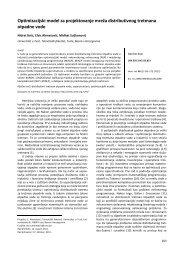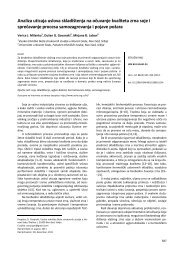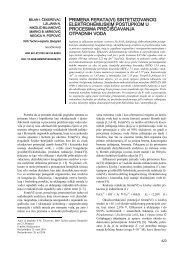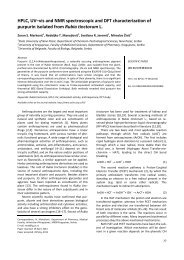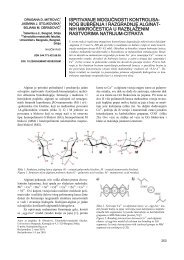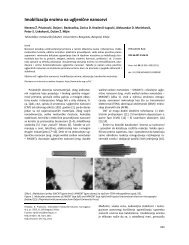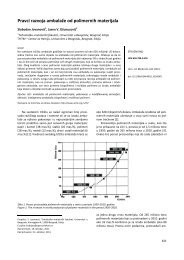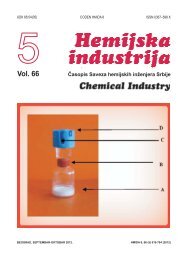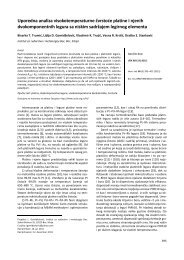PRODUCTION OF CERAMICS FROM COAL FLY ASH - doiSerbia
PRODUCTION OF CERAMICS FROM COAL FLY ASH - doiSerbia
PRODUCTION OF CERAMICS FROM COAL FLY ASH - doiSerbia
You also want an ePaper? Increase the reach of your titles
YUMPU automatically turns print PDFs into web optimized ePapers that Google loves.
BILJANA ANGJUSHEVA<br />
EMILIJA FIDANCEVSKA<br />
VOJO JOVANOV<br />
Faculty of Technology and Metallurgy,<br />
University “Ss. Cyril and<br />
Methodius”, Skopje,<br />
Republic of Macedonia<br />
SCIENTIFIC PAPER<br />
UDC 666.3/.7(497.17):666.3–187<br />
DOI 10.2298/CICEQ110607001A<br />
In the last decade there has been a growing<br />
interest for solving problems related to environmental<br />
pollution with industrial wastes. One such example is<br />
industrial waste from the coal combustion process in<br />
thermal power plants. The total quantity of coal combustion<br />
by-products in Europe for 2008 is 56 million<br />
tons [1]. The highest percent (around 66.6%) belongs<br />
to fly ash but the quantity that is utilized exceeds no<br />
more than 17 million tons. The highest utilization of<br />
coal fly ash is in the construction industry as a concrete<br />
addition or a replacement for part of the cement<br />
[2-5], then road base construction [6,7], landfill liners<br />
[8-10], and agriculture [11,12]. However, new applications<br />
and possibilities for utilization of coal fly ash are<br />
needed. Fly ash is a by-product of the burning of coal<br />
between the temperature range of 1100 and 1450 °C,<br />
and contains valuable oxides, such as SiO 2, Al 2O 3,<br />
CaO, Fe 2O 3 and other oxides provided as powder<br />
with fine particles [13]. There has been considerable<br />
research on the production of ceramics from coal fly<br />
ash with the addition of the natural raw materials or<br />
waste materials [14-16].<br />
Fukumoto et al. [17] explored the suitability of<br />
using fly ash and clay in order to produce composite<br />
material with satisfactory mechanical properties. Re-<br />
Correspondening author: B. Angjusheva, Faculty of Technology<br />
and Metallurgy, University “Ss. Cyril and Methodius”, Rudjer<br />
Bošković 16, Skopje, Republic of Macedonia.<br />
E-mail: angjushevab@yahoo.com<br />
Paper received: 7 June, 2011<br />
Paper revised: 17 November, 2011<br />
Paper accepted: 3 January, 2012<br />
Available on line at<br />
Association of the Chemical Engineers of Serbia AChE<br />
www.ache.org.rs/CICEQ<br />
Chemical Industry & Chemical Engineering Quarterly 18 (2) 245−254 (2012) CI&CEQ<br />
<strong>PRODUCTION</strong> <strong>OF</strong> <strong>CERAMICS</strong> <strong>FROM</strong><br />
<strong>COAL</strong> <strong>FLY</strong> <strong>ASH</strong><br />
Dense ceramics are produced from fly ash from REK Bitola, Republic of Macedonia.<br />
Four types of fly ash from electrofilters and one from the collected<br />
zone with particles
B. ANGJUSHEVA, E. FIDANCEVSKA, V. JOVANOV: <strong>PRODUCTION</strong> <strong>OF</strong> <strong>CERAMICS</strong>… CI&CEQ 18 (2) 245−254 (2012)<br />
MATERIALS AND METHODS<br />
Characterization of the fly ash<br />
Fly ash from the thermal power plant REK Bitola,<br />
Republic of Macedonia, was used as raw material<br />
for producing ceramics. Four fly ash samples with<br />
lignite origin from different zones of electrofilter, coded<br />
as FA1, FA2, FA3 and FA4 and from the collected<br />
zone coded as CZ, were the subject of this study.<br />
The morphology of the received fly ashes was<br />
followed by scanning electron microscope (Leica S<br />
440I) and the particle size distribution was determined<br />
by sieving analyses (Retsch AS200). Further investigation<br />
was conducted on the fly ashes with a fraction<br />
lower than 0.063 mm.<br />
Chemical analysis of the fly ashes was carried<br />
out by X-ray fluorescence (ARL 990XP). Unburnt carbon<br />
content was determined from the loss of ignition<br />
(LOI) on a dried sample heated at 900 °C for 2 h at<br />
maximum temperature. The phase composition of the<br />
fly ashes was performed by using X-ray diffraction<br />
(Philips, model PV 105-1) operating at CuKα radiation<br />
at an accelerating voltage of 40 kV and a current of<br />
40 mA. The Pycnometer method was applied for the<br />
purpose of determining the specific gravity. In order to<br />
determine the specific surface area of the fly ashes,<br />
the BET method (Micromerits, Gemini) was applied.<br />
The thermal properties of the fly ashes were determined<br />
using a heating microscope (Leitz Wetzlar) in<br />
the temperature interval from room temperature (RT)<br />
to 1400 °C, in air atmosphere with a heating rate of 10<br />
°C/min.<br />
Consolidation of the fly ash samples<br />
The fly ash particles with dimensions lower than<br />
0.063 mm were granulated using a certain amount of<br />
water from 17 to 20 wt.%, gradually drop-wise into fly<br />
ash. The moistened fly ash was granulated through a<br />
0.6 mm sieve. Pressing of the granulated fly ash was<br />
performed by uniaxial press (Weber Pressen KIP<br />
100) at p = 133 MPa. Green density was calculated<br />
from the weight to volume ratio of unfired samples.<br />
Fly ash samples were sintered in the chamber<br />
furnace in air atmosphere at temperatures of 950,<br />
1000, 1050 and 1100 °C with a holding time at a maximum<br />
temperature of 60 min. The applied heating<br />
rates for sintering were 3 and 10 °C/min, while the<br />
cooling of the samples was not controlled.<br />
Characterization of the sintered samples<br />
Bulk density was calculated from the weight to<br />
volume ratio of the sintered samples. Sample shrinkage<br />
(%) was measured from the differences in the<br />
green and fired samples’ length. Water absorption of<br />
246<br />
the sintered samples was determined from the difference<br />
between dry mass, m dry, and surface dry mass,<br />
m sur.dry, after immersion in cold water. Porosity of the<br />
samples was calculated from the relative density.<br />
The microstructure of the sintered fly ash samples<br />
was examined by means of scanning electron<br />
microscopy (Leica S440I). The samples were coated<br />
with gold prior to examination.<br />
The bending strength was measured on the sintered<br />
samples (with the dimensions of 50 mm×5 mm×<br />
×5 mm), which were subjected to a 3-point bending<br />
strength tester (Netzsch 401/3) with a 30 mm span<br />
and a 0.5 mm/min loading rate. The compressive<br />
strength tests were carried out using an Instron testing<br />
machine (model 1126) with a crosshead speed of<br />
0.5 mm/min. For these mechanical tests at least five<br />
samples were used per each mentioned type, and the<br />
results were averaged.<br />
Linear thermal expansion of the dense compacts<br />
was determined using the dilatometer (Netzsch<br />
402E) in the air atmosphere and temperature interval<br />
RT-650 °C-RT, with a heating rate of 2 °C/min.<br />
RESULTS AND DISCUSSION<br />
Morphology of the received fly ashes<br />
The morphology of the received fly ashes (CZ<br />
and FA1-FA4) are presented in Figure 1.<br />
The typical morphology of fly ash powders can<br />
be seen from the SEM micrographs in Figure 1. Spherical<br />
particles with a broad particle size distribution,<br />
the porous sphere and particles with irregular geometry<br />
and dimensions are evident. The particles in<br />
CZ have the most heterogenic distribution and the<br />
dimensions varied from 10 to 200 μm, as seen in Figure<br />
1a. A more uniform geometry and more spherical<br />
particles are present in the ashes starting from<br />
FA1 up to FA4. Namely, the dimensions of the particles<br />
varied for FA1 from 5 to 100 μm, in Figure 1b, for<br />
FA2 from 2 to 50 μm, in Figure 1c, for FA3 from 2 to<br />
20 μm, in Figure 1d, and for FA4 from 1 to10 μm, in<br />
Figure 1e. In addition, the size of agglomerates differs<br />
in fly ash powders and the degree of agglomeration is<br />
related to the particles’ size. The highest agglomeration<br />
is present in FA4, Figure 1e, due to the presence<br />
of the smallest particle.<br />
Particle size distribution of received fly ashes<br />
The particle size distribution of the fly ashes is<br />
given in Table 1.<br />
It is evident from Table 1 that in all fly ashes the<br />
fraction 0.063 mm is the most dominant. Namely, the<br />
quantity of 0.063 mm per fraction in CZ is 43.60 wt.%,<br />
but the quantity of the same fraction in FA4 is doubled
B. ANGJUSHEVA, E. FIDANCEVSKA, V. JOVANOV: <strong>PRODUCTION</strong> <strong>OF</strong> <strong>CERAMICS</strong>… CI&CEQ 18 (2) 245−254 (2012)<br />
(82.36 wt.%), so the FA4 is the finest fly ash. The low<br />
content of the coarse fractions (larger then 0.250 mm)<br />
is evident in all fly ashes. The content of the coarse<br />
fraction for the CZ is 11.9 wt.% and subsequently decreases<br />
for the rest of the fly ashes reaching the value<br />
of 0.24 wt.% for FA4. The medium fraction (0.250-<br />
–0.125 mm) in CZ is 43.80 wt.% and it is almost the<br />
same as the content of the fine fraction. The content<br />
of the medium fraction for the fly ashes FA1 to FA4<br />
decreases and the lowest content is evident in FA4<br />
(16.9 wt.%).<br />
Table 1. Particle size analysis of the fly ash<br />
(a) (b) (c)<br />
Diameter, mm<br />
CZ<br />
Content, wt.%<br />
FA1 FA2 FA3 FA4<br />
+ 1.0 0.6 0.5 0.4 – –<br />
- 1.0 + 0.5 2.20 1.40 0.80 0.05 0.04<br />
- 0.5 + 0.25 9.10 6.60 2.20 0.40 0.20<br />
- 0.25 + 0.125 18.90 18.90 12.60 3.70 2.20<br />
- 0.125 + 0.063 24.90 23.60 26.80 18.1 14.70<br />
- 0.063 + 0.045 43.60 48.60 56.60 77.6 82.36<br />
Σ 99.3 99.6 99.4 99.85 99.5<br />
As the fraction less than 0.063 mm is the most<br />
reactive part of fly ashes, it was used as a starting<br />
point material for the next investigations for all types<br />
of the received fly ashes.<br />
(d) (e)<br />
Figure 1. SEM Micrographs of the investigated fly ashes: a - CZ, b - FA1, c - FA2, d - FA3 and e - FA4 (bar 10 μm).<br />
Chemical and physical properties of the fly ashes<br />
Chemical composition and loss of ignition<br />
The chemical composition of the investigated fly<br />
ashes (a fraction less than 0.063 mm) is given in<br />
Table 2.<br />
Table 2. Chemical composition of the fly ashes<br />
Oxide<br />
CZ FA1<br />
Content, wt.%<br />
FA2 FA3 FA4<br />
SiO2 50.33 53.31 49.20 48.81 49.51<br />
Al2O3 18.59 19.92 18.78 17.81 17.62<br />
Fe2O3 7.71 7.68 7.72 7.80 7.91<br />
CaO 13.76 10.74 13.23 14.31 13.77<br />
MgO 3.05 2.70 3.04 3.39 3.36<br />
Na2O 1.07 0.84 0.78 0.70 0.69<br />
K2O 1.41 1.51 1.45 1.38 1.46<br />
SO3 1.44 1.03 1.78 2.76 3.52<br />
LOI 2.60 2.20 2.03 1.78 1.57<br />
Σ 99.96 99.93 98.01 98.74 99.41<br />
It is evident from Table 2 that the major chemical<br />
components in the fly ashes are: SiO2, Al 2O 3<br />
and CaO. In all the fly ashes, the content of CaO is<br />
higher than 10% and can be characterized as Class C<br />
fly ashes. According to ASTM C618 [23] fly ashes<br />
from lignite coals have a relatively large content of<br />
CaO and they are classified as Class C ashes.<br />
247
B. ANGJUSHEVA, E. FIDANCEVSKA, V. JOVANOV: <strong>PRODUCTION</strong> <strong>OF</strong> <strong>CERAMICS</strong>… CI&CEQ 18 (2) 245−254 (2012)<br />
Free CaO was not detected in the investigated<br />
fly ashes. According to Kiattikomol et al. [24] the<br />
pozzolanic activity of the fly ash is influenced by calcium<br />
in the glass, and not by the free calcium oxide<br />
nor crystalline CaO.<br />
The content of LOI slightly decreased, starting<br />
from CZ (2.60 wt.%) towards FA4 (1.57 wt.%). The<br />
values of LOI are related to the existence of the unburnt<br />
coal particles, and according to Itskos et al. [25]<br />
it is also a result of the thermal disruption of some of<br />
its components.<br />
Phase composition<br />
From the XRD patterns of the CZ and FA4 presented<br />
in Figure 2, the presence of the principal crystalline<br />
phases is obvious: SiO2 - quartz, CaAl2Si2O8 -<br />
anorthite, Fe2O3 - hematite, NaAlSi3O8 - albite, CaSO4 - anhydrite and an amorphous phase. In addition, the<br />
presence of quartz and anorthite are more emphasized<br />
in the CZ compared to FA4. The detected anhydrite<br />
is a characteristic phase in class C fly ashes.<br />
Gikunoo [26] reports that for most of the ashes, only<br />
about half of the SO3 occurred as anhydrite while the<br />
rest play a role in the formation of alkali sulphates.<br />
248<br />
From the intensity of the peaks it is obvious that anhydrite<br />
is more present in FA4. This is in relation to<br />
the SO3 content detected from the chemical analysis<br />
in Table 2. Namely, the SO3 content in CZ is 1.44<br />
wt.%, but the amount of SO 3 in FA4 is more than<br />
double (3.52 wt.%). The existence of anhydrite in the<br />
finer fractions of the ashes is confirmed in the literature<br />
as well [25]. From the XRD patterns it is as well<br />
obvious that there is a significant difference in the<br />
amorphous phase present in the FA4 compared to<br />
CZ, which is reflected in the high reactivity of FA4<br />
compared to CZ. According to [27] the glass fraction<br />
in fly ashes usually varies between 70 and 89% depending<br />
on the type and coal source, degree of pulverisation,<br />
combustion conditions in the furnace, and the<br />
cooling rate of the combustion residue.<br />
Specific surface area and specific gravity of the fly<br />
ashes and green density of the compacts<br />
Table 3 presents the specific gravity, surface<br />
area of the fly ashes and green density of the compacts.<br />
The specific gravity of fly ashes is in the range<br />
between 2.28 and 2.42 g/cm 3 . It is reported [26] that<br />
Figure 2. XRD Data for CZ and FA4 - as received, and CZ and FA4 sintered at 1100 °C dT/dτ =1 0 °C/min.
B. ANGJUSHEVA, E. FIDANCEVSKA, V. JOVANOV: <strong>PRODUCTION</strong> <strong>OF</strong> <strong>CERAMICS</strong>… CI&CEQ 18 (2) 245−254 (2012)<br />
the specific gravity of fly ash generally varies from 1.3<br />
to 4.8 g/cm 3 and it is closely related to the shape and<br />
chemical composition of fly ash particles.<br />
Table 3. Specific gravity, specific surface area of the fly ashes<br />
and green densities of the compacts<br />
Property CZ FA1 FA2 FA3 FA4<br />
Specific gravity, g/cm 3 2.28 2.27 2.32 2.38 2.42<br />
Specific surface area, m 2 /g 3.09 3.68 4.99 6.10 11.31<br />
Green density, g/cm 3 1.524 1.519 1.520 1.524 1.556<br />
The specific surface area increased from FA1 to<br />
FA4 reaching the value of 11.31 m 2 /g and it is almost<br />
3.5 times higher than the value of the CZ. The differences<br />
are due to the different size, form and relief of<br />
the particles.<br />
Concerning the green density, FA4 showed the<br />
highest density which is a result of the better packing<br />
of the particles during the pressing as a consequence<br />
of the high amount of fine particles present in FA4.<br />
Higher green density promotes a greater density of<br />
the sintered compacts [29].<br />
Thermal properties of the fly ashes<br />
The thermal properties of the fly ashes are given<br />
in Table 4.<br />
Table 4. Thermal properties of the investigated fly ashes<br />
According to the data presented in Table 4, it is<br />
evident that all types of fly ashes have a narrow region<br />
of sintering (1190-1250)±10 °C, except for FA4<br />
(1110-1220)±10 °C. The melting temperature for CZ<br />
is 1300±10 °C, while for the rest of the fly ashes, they<br />
are in the interval from (1270-1320)±10 °C, and for<br />
FA4, it is 1240±10 °C.<br />
Physical and thermal properties of sintered samples<br />
The variation of density, porosity, water absorption<br />
and linear shrinkage with a temperature at a<br />
heating rate of 3 and 10 °C/min are presented in Figures<br />
3-6.<br />
The densities of the all FA compacts in the sintering<br />
region from 950 to 1050 °C for both heating<br />
rates are close, i.e., in the ranges from 1.50±0.02 to<br />
1.61±0.02 g/cm 3 (Figures 3a and 3b). For all the fly ash<br />
compacts, the density at a temperature of 1100 °C increased<br />
for both the applied heating rates, particularly<br />
for FA4. One of the reasons for the highest density of<br />
FA4 (2.35±0.02 g/cm 3 ) is a lower content of residual<br />
coal and as a consequence during the sintering the<br />
lower porosity has been produced. The particle with<br />
no defined geometry influenced the package of the<br />
powders. Thus, the smaller the particle size, the<br />
smaller the space (pores) among the particles that is<br />
generated during the package of the powders, and in<br />
Sample Significant shrinkage, °C Softening temperature, °C Melting temperature, °C Sintering region, °C<br />
CZ 1190±10 1240±10 1300±10 1190-1240±10<br />
FA1 1194±10 1250±10 1320±10 1194-1250±10<br />
FA2 1200±10 1246±10 1310±10 1200-1246±10<br />
FA3 1180±10 1200±10 1270±10 1180-1200±10<br />
FA4 1110±10 1220±10 1240±10 1110-1220±10<br />
ρ [g/cm 3 ]<br />
2,40<br />
2,20<br />
2,00<br />
1,80<br />
1,60<br />
1,40<br />
1,20<br />
1,00<br />
900 950 1000 1050 1100 1150<br />
T [ o C], dT/dτ=3 o /min<br />
CZ<br />
FA1<br />
FA2<br />
FA3<br />
FA4<br />
2,60<br />
2,40<br />
2,20<br />
2,00<br />
1,80<br />
1,60<br />
1,40<br />
1,20<br />
1,00<br />
900 950 1000 1050 1100 1150<br />
T [ 0 C] , dT/dτ=10 0 /min<br />
(a) (b)<br />
Figure 3. Density of sintered fly ash compacts using heating rate: a - 3 and b - 10 °C/min.<br />
ρ [g/cm 3 ]<br />
CZ<br />
FA1<br />
FA2<br />
FA3<br />
FA4<br />
249
B. ANGJUSHEVA, E. FIDANCEVSKA, V. JOVANOV: <strong>PRODUCTION</strong> <strong>OF</strong> <strong>CERAMICS</strong>… CI&CEQ 18 (2) 245−254 (2012)<br />
250<br />
Porosity [%]<br />
Water absorption [%]<br />
ΔL/L, [%]<br />
40<br />
35<br />
30<br />
25<br />
20<br />
15<br />
10<br />
5<br />
0<br />
900 950 1000 1050 1100 1150<br />
25<br />
20<br />
15<br />
10<br />
5<br />
T [ o C], dt/dτ=3 o /min<br />
CZ<br />
FA1<br />
FA2<br />
FA3<br />
FA4<br />
Porosity [%]<br />
40<br />
35<br />
30<br />
25<br />
20<br />
15<br />
10<br />
5<br />
0<br />
900 950 1000 1050 1100 1150<br />
T [ o C], dt/dτ=10 o /min<br />
(a) (b)<br />
Figure 4. Porosity of the sintered fly ash compacts using heating rate: a - 3 and b - 10 °C/min.<br />
0<br />
900 950 1000 1050 1100 1150<br />
-10<br />
-12<br />
-14<br />
T [ 0 C], dt/dτ=3 0 /min<br />
CZ<br />
FA1<br />
FA2<br />
FA3<br />
FA4<br />
25<br />
20<br />
15<br />
10<br />
5<br />
0<br />
900 950 1000 1050 1100 1150<br />
T [ 0 C], dt/dτ=10 0 /min<br />
(a) (b)<br />
Figure 5. Water absorption of the sintered fly ash compacts using heating rate: a - 3 and b - 10 °C/min.<br />
0<br />
900 950 1000 1050 1100 1150<br />
-2<br />
-4<br />
-6<br />
-8<br />
T [ o C], dT/dτ=3 o /min<br />
CZ<br />
FA1<br />
FA2<br />
FA3<br />
FA4<br />
Water absorption [%]<br />
0<br />
-2<br />
-4<br />
-6<br />
-8<br />
-10<br />
-12<br />
-14<br />
-16<br />
950 1000 1050 1100<br />
T [ 0 C], dT/dτ=10 0 /min<br />
(a) (b)<br />
Figure 6. Shrinkage of sintered fly ash compacts using heating rate: a - 3 and b - 10 °C/min.<br />
the course of sintering the smaller pores are easily<br />
eliminated and the compacts with lower porosity are<br />
produced [29].<br />
ΔL/L [%]<br />
Concerning the differences of the heating rates<br />
using the heating rate of 3 °C/min, the density was<br />
2.18±0.02 g/cm 3 , but for the heating rate of 10 °C/min,<br />
CZ<br />
FA1<br />
FA2<br />
FA3<br />
FA4<br />
CZ<br />
FA1<br />
FA2<br />
FA3<br />
FA4<br />
CZ<br />
FA1<br />
FA2<br />
FA3<br />
FA4
B. ANGJUSHEVA, E. FIDANCEVSKA, V. JOVANOV: <strong>PRODUCTION</strong> <strong>OF</strong> <strong>CERAMICS</strong>… CI&CEQ 18 (2) 245−254 (2012)<br />
the density of 2.35±0.02 g/cm 3 was achieved, which<br />
is in accordance with the literature [30].<br />
From Figure 4 it is evident that the porosity of<br />
the all fly ash samples decrease at a temperature of<br />
1100 °C, and it is the most expressed for FA4. Thus,<br />
the porosity for CZ, sintered at 1100 °C using a heating<br />
rate of 10 °C/min, was 28.5±2%, while the porosity<br />
for FA4 samples, sintered under the same conditions,<br />
was 2.96±0.5%.<br />
The data for water absorption presented in Figure<br />
5 shows that the FA4 has the lowest value (2.39<br />
wt.%) at a temperature of 1100 °C, using a heating<br />
rate of 10 °C/min. The values for density, water absorption<br />
and porosity are better than the values reported<br />
by Ilic et al. [31] and Pimraksa et al. [22].<br />
The maximal shrinkage has the sample FA4 (13<br />
wt.%) and according to [32] it is a result of the high<br />
reactivity, i.e., the higher factor of geometrical activity.<br />
The characteristic of thermal expansion determined<br />
in the interval of RT-650 °C-RT showed absence<br />
of hysteresis, which proves that the obtained<br />
ceramic compacts are in thermal equilibrium [19]. The<br />
technical coefficient for CZ and FA4, sintered at 1100<br />
°C using the heating rate of 10 ºC/min, is 8.30 and<br />
8.58×10 -6 /°C, respectively, and corresponds to the value<br />
reported in literature [33].<br />
Mechanical properties of the sintered samples<br />
In Figure 7, the bending strength of the fly ash<br />
compacts versus the sintering temperature for both<br />
the heating rates are presented.<br />
Generally, for all FA compacts, by increasing the<br />
temperature up to 1050 °C the bending strength is<br />
also increased and there are no significant differences<br />
in bending strengths, no matter if the heating rate<br />
was 3 or 10 °C/min. The significant difference of<br />
σ [MPa]<br />
50<br />
45<br />
40<br />
35<br />
30<br />
25<br />
20<br />
15<br />
10<br />
5<br />
0<br />
900 950 1000 1050 1100 1150<br />
T [ o C], dT/dτ=3 o /min<br />
CZ<br />
FA1<br />
FA2<br />
FA3<br />
FA4<br />
bending strength is evident at higher sintering temperatures.<br />
The FA4 compacts showed the highest values<br />
of bending strength for the investigated sintering<br />
region. Namely, the bending strength for FA4 at 950 °C<br />
was 14.26±1 MPa, but at the final temperature of<br />
1100 °C the maximum bending strength of 47.01±2<br />
MPa was reached. The highest values of the bending<br />
strength of FA4 compacts is directly related to the<br />
lower residual coal content, narrow particle size distribution<br />
and the morphology of the fly ash particles. As<br />
a consequence the compacts with high density/lower<br />
porosity and high mechanical properties were obtained.<br />
The bending strength for CZ compacts was<br />
the lowest for the whole investigated temperature region,<br />
starting from 6±1 MPa at 950 °C up to 16.5±1<br />
MPa at 1100 °C.<br />
Further research was conducted only to the FA4<br />
and CZ compacts, as the most favorable investigated<br />
systems due to the highest physical and mechanical<br />
properties - FA4, and the integral quantity of CZ produced<br />
during the combustion of coal.<br />
Figure 8 presents the variation of the compressive<br />
strength of CZ and FA4 compacts with the sintering<br />
temperature for both the heating rates.<br />
It is evident that for the FA4 the compressive<br />
strength increased from 70±3 to 170±5 MPa by increasing<br />
the sintering temperature from 950 to 1100<br />
°C using the heating rate of 10 °C /min. The bending<br />
and compressive strength for the sintered FA4 compacts<br />
are higher than those reported by Pimraksa et<br />
al. [22] for the investigated temperature region.<br />
It is obvious that the mechanical properties of<br />
the investigated fly ash compacts have generally<br />
higher values when the heating rate of 10 °C/min was<br />
used during the sintering. It can be explained that one<br />
of the reasons is limiting the oxygen access to the<br />
50<br />
45<br />
40<br />
35<br />
30<br />
25<br />
20<br />
15<br />
10<br />
5<br />
0<br />
900 950 1000 1050 1100 1150<br />
T [ 0 C], dt/dτ=10 0 /min<br />
(a) (b)<br />
Figure 7. Bending strength of the fly ash compact sintered at different temperature using heating rate: a - 3 and b - 10 °C/min.<br />
σ [MPa]<br />
CZ<br />
FA1<br />
FA2<br />
FA3<br />
FA4<br />
251
B. ANGJUSHEVA, E. FIDANCEVSKA, V. JOVANOV: <strong>PRODUCTION</strong> <strong>OF</strong> <strong>CERAMICS</strong>… CI&CEQ 18 (2) 245−254 (2012)<br />
carbon in the compact interior described in [34]. Applying<br />
the higher heating rate during the sintering, the<br />
surface of the compact is sintered and becomes virtually<br />
impervious to air. As a result, the carbon particles<br />
encapsulated inside the specimen were not oxidized<br />
and did not generate any pores.<br />
σ [MPa]<br />
252<br />
180<br />
160<br />
140<br />
120<br />
100<br />
80<br />
60<br />
40<br />
20<br />
0<br />
900 950 1000 1050 1100 1150<br />
Sintering temperature [ 0 C],<br />
CZ, dt/dt=3<br />
C/min<br />
FA4, dt/dt=3<br />
C/min<br />
CZ, dt/dt=10<br />
C/min<br />
FA4, dt/dt=10<br />
C/min<br />
Figure 8. Plot of compressive strength of the samples in relation<br />
to sintering temperature.<br />
XRD Studies of the sintered samples<br />
The XRD patterns for received CZ and FA4 and<br />
sintered compacts of CZ and FA4 at a temperature of<br />
1100 °C with a heating rate of 10 °C/min, are shown<br />
in Figure 2.<br />
The crystalline phases in received CZ and FA4<br />
are: quartz, anorthite, hematite and albite, and they<br />
remain (the same) in the sintered samples of CZ and<br />
FA4. Sintering the samples of CZ and FA4 at 1100 °C<br />
reduce the peaks of quartz (SiO 2) and anhydrite<br />
(CaSO4) and are in accordance with [25]. On the other<br />
hand, sintering promotes the anorthite peaks<br />
(CaAl 2Si 2O 8). The relatively high content of CaO present<br />
in the received fly ashes is the reason for the<br />
formation of anorthite. As reported by Erol et al. [35],<br />
the substitution of the Ca ion into the SiO 2–Al 2O 3 couple<br />
lead to the occurrence of anorthite at high temperatures.<br />
In addition, the new crystalline phase of diopside<br />
[Ca(Mg,Al)(Si,Al) 2O 6] was detected and the formation<br />
of diopside should be forced [36], because it generally<br />
displayed better physical properties due to the interlocking<br />
microstructure of its crystals.<br />
The amorphous phase especially present in FA4<br />
has been reduced during the sintering of the compacts.<br />
Microstructural analysis<br />
The microstructures of the fractured surface of<br />
the compacts CZ and FA4 sintered at 1100 °C with a<br />
heating rate of 10 °C/min are presented in Figures 9<br />
and 10, respectively.<br />
(a)<br />
(b)<br />
Figure 9. SEM Images for CZ, T = 1100 °C/1h,<br />
dT/dτ = 10 °C/min; bars: a)10 and b) 2 μm.<br />
(a)<br />
(b)<br />
Figure 10. SEM Images for FA4, T = 1100 °C/1h,<br />
dT/dτ = 10 °C/min; bars: a)10 and b) 2 μm.
B. ANGJUSHEVA, E. FIDANCEVSKA, V. JOVANOV: <strong>PRODUCTION</strong> <strong>OF</strong> <strong>CERAMICS</strong>… CI&CEQ 18 (2) 245−254 (2012)<br />
The microstructure of CZ compacts, Figures 9a<br />
and 9b, is heterogeneous with evident presence of<br />
liquid bridges among the grains. The dimension of the<br />
grains varied in a wide interval (from 5 to 70 μm). The<br />
biggest part of the spherical grains has kept their<br />
individuality and their dimensions are in the interval<br />
from 8 to 15 μm. The presences of the porous grains<br />
(10-20 μm) are also evident. The dimensions of intergranular<br />
pores are 2±1 μm.<br />
Figures 10a and 10b show the microstructure of<br />
the FA4 which is more homogeneous and smoother<br />
compared to the microstructure of CZ sintered at the<br />
same temperature. A significant presence of the liquid<br />
phase is evident through the whole surface of the<br />
sintered compact. There are also closed pores with<br />
dimensions no larger than 10 μm. One of the basic<br />
reasons for better densification of the FA4 compacts<br />
is the morphology of the particles. The different form<br />
of the particles and their smaller dimensions are the<br />
reasons for more frequent contacts among the particles.<br />
The narrow particle size distribution of FA4 is<br />
also the reason for interparticle neck formation and<br />
appearance of liquid phase at lower sintering temperatures,<br />
as reported in literature [29].<br />
CONCLUSIONS<br />
- Fly ash from the thermal power plant REK Bitola,<br />
Republic of Macedonia, was used for production<br />
of dense ceramics.<br />
– The process variables of the sintering were:<br />
temperature in the interval between 950 and 1100 °C,<br />
and a heating rate of 3 and 10 °C/min. Four different<br />
fly ashes from different zones of electro filter (FA1<br />
and FA4) and one from the collected zone (CZ) with a<br />
granulation of
B. ANGJUSHEVA, E. FIDANCEVSKA, V. JOVANOV: <strong>PRODUCTION</strong> <strong>OF</strong> <strong>CERAMICS</strong>… CI&CEQ 18 (2) 245−254 (2012)<br />
[28] A. Medina, P. Camero, X. Querol, N. Moreno, B. de Leon,<br />
M. Almanza, G. Vargas, M. Izquierdo, O. Font, J. Haz.<br />
Mater. 181 (2010) 82-90<br />
[29] E. Benavidez, C. Grasselli, N. Quaranta, Ceram. Inter. 29<br />
(2003) 61-68<br />
[30] A. Karamanov, M. Aloisi, M. Pelino, J. Eur. Ceram. Soc.<br />
25 (2005) 1531-1540<br />
[31] M. Ilic, C. Cheeseman, C. Sollars, J. Knight, Fuel 82<br />
(2003) 331-336<br />
[32] V. Adell, C.R. Cheeseman, M. Ferraris, M. Salvo, F.<br />
Smeacetto, A.R. Boccaccini, Mater. Charact. 58 (2007)<br />
980-988<br />
254<br />
BILJANA ANGJUSHEVA<br />
EMILIJA FIDANCEVSKA<br />
VOJO JOVANOV<br />
Faculty of Technology and Metallurgy,<br />
University “Ss. Cyril and Methodius”,<br />
Skopje, Republic of Macedonia<br />
NAUČNI RAD<br />
[33] A. Karamanov, M. Pelino, M. Salvo, I. Metekovits, J. Eur.<br />
Ceram. Soc. 23 (2003) 1609-1615<br />
[34] A. Mishulovich, J.L. Evanko, Ceramic International ash<br />
Symposium, Center for applied Energy Research, University<br />
of Kentucky, Paper 18 (2003)<br />
[35] M. Erol, S. Kűçűkbayrak, A. Ersoy Meriçboyu, Fuel 87<br />
(2008) 1334-1340<br />
[36] Y.J. Park, S.O. Moon, J. Heo, Ceram. Inter. 29 (2003)<br />
223-227.<br />
PROIZVODNJA KERAMIKE OD PEPELA UGLJA<br />
Gusta keramika se dobija iz pepela iz REK Bitola u Republici Makedoniji. Predmet ovog<br />
istraživanja su četiri tipa pepela iz elektro filtera i jedan tip sa deponija sa česticma<br />
manjim od 0,063 mm. Konsolidacija se postiže pod pritiskom (p = 133 MPa) i sinterovanjem<br />
(na temperaturama 950, 1000, 1050 ili 1100 °C ibrzinom zagrevanja od 3 ili 10<br />
°C/min). Zgušnjavanje se postiže sinterovanjem tečnom fazom i reakcijom u čvrstom<br />
stanju, pri čemu se formira diopsid (Ca(Mg,Al)(Si,Al)2O6). Keramika optimalnih karakteristika<br />
(poroznosti 2,96±0,5%, jačine savijanja 47±2 MPa, čvrstoće 170±5 MPa) je dobijena<br />
na1100 °C brzinom zagrevanja od 10 °C/min.<br />
Ključne reči: pepeo, keramika, sinterovanje, jačina savijanja, čvrstoća.




